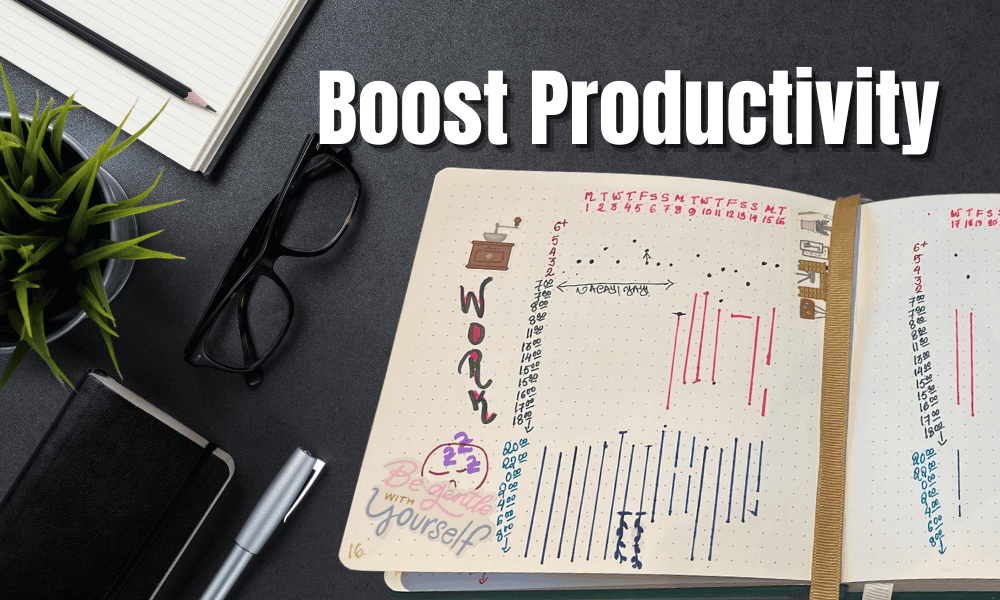At its core, mindfulness is about being fully present in the moment, an approach that can transform how we engage with our work. To use it to improve productivity, you need to bring full attention to work while being aware of your mental and emotional state.
Table of Contents
Benefits of Mindfulness For Productivity
Mindfulness practices are not merely about finding moments of calm in the storm of work-related stress; they are also about enhancing crucial aspects of cognitive functioning.
- Regular mindfulness exercises have been shown to improve focus, allowing professionals to concentrate more fully on the task at hand. This heightened focus naturally leads to a boost in productivity, as a more concentrated mind is less prone to distractions and more capable of thorough, quality work.
- It encourages creativity, a valuable asset in the workplace. It opens up mental space, allowing fresh ideas and innovative solutions to surface.
- Mindfulness also contributes to better decision-making and emotional intelligence, enhancing overall work performance.
By fostering a mindful approach to tasks and interactions, employees and leaders alike can create a more positive, productive, and creative work environment. Here are five techniques that can help you achieve this:

1. Mindful Breathing Techniques
Mindful breathing involves focusing your attention on your breath, the inhalation and exhalation, and observing each breath without trying to change or regulate it in any way. This simple act of centering your attention on your breathing can have a transformative effect on your mind and body. Some of its benefits include:
- Stress Reduction: By focusing on your breath, you shift away from stress-inducing thoughts and enter a state of calm, which lowers cortisol levels, the body’s stress hormone.
- Improved Focus: Routinely practicing mindful breathing trains your brain to focus on the present moment, which is essential for productivity and efficiency in work tasks.
- Emotional Regulation: Regular practice helps in managing emotions, leading to a more balanced and composed state of mind. This is particularly beneficial in high-pressure work environments where emotional reactivity can be a hindrance.
Incorporating Mindful Breathing into Daily Work Routines
There are various ways that you can incorporate mindful breathing into your daily work routines:
- Begin your workday with a 5-minute mindful breathing session. This sets a calm and focused tone for the day ahead.
- Replace regular coffee or smoke breaks with short breathing exercises. Even a few minutes can be effective in re-centering your mind.ransition Moments:
- Use the moments between tasks, such as after sending an email or before joining a meeting, for a quick mindful breathing exercise to reset your focus.
- When you feel overwhelmed or stressed, take a moment to focus on your breath. This can help in regaining composure and clarity.
- Conclude your workday with a mindful breathing exercise to help separate your work life from your personal life, reducing work-related stress at home.
By integrating these simple yet effective mindful breathing practices into your daily work routine, you can reap the benefits of reduced stress and improved focus, leading to a more productive and fulfilling work experience.

2. Body Scan
A body scan mindfulness technique involves paying attention to different parts of your body in a sequential manner, typically starting from the toes and moving upwards. This practice encourages heightened awareness and presence, fostering a deep connection between the mind and body. It plays a pivotal role in increasing self-awareness by bringing attention to bodily sensations, tensions, and relaxation, often overlooked in the hustle of daily work life. As you become more aware of these physical sensations, you can better recognize the early signs of stress and tension, thereby addressing them proactively.
Instructions for Performing a Body Scan at Work:
To perform an effective body scan:
- Sit comfortably in your chair, feet flat on the floor, hands resting on your lap. Ensure your posture is relaxed yet upright.
- Take a few deep breaths to center your focus. Inhale deeply through your nose, and exhale slowly through your mouth.
- Begin the body scan by directing your attention to your feet. Notice any sensations, tension, or warmth in your toes and soles.
- Gradually shift your focus up through your body—ankles, calves, knees, thighs, and so on. Spend a moment at each area, noticing any sensations or tension.
- If you notice any areas of tension, acknowledge it without judgment and imagine releasing this tension with each exhale.
- Pay special attention to the back and shoulders, common areas for tension accumulation, especially while sitting.
- Move down your arms to your hands, noticing sensations in your fingers and palms.
- Finally, bring your attention to your face and head. Notice any tension in your jaw, forehead, or scalp.
- Finish your body scan with a few deep breaths, and as you exhale, open your eyes and return to your surroundings, carrying this newfound awareness with you.
By routinely practicing the body scan technique, especially during work breaks or moments of high stress, you can significantly improve your self-awareness, manage stress more effectively, and enhance your overall well-being in the workplace.
3. Mindful Walking
Mindful walking is a form of mindfulness meditation in motion. Unlike traditional meditation, which is usually practiced in stillness, mindful walking involves being fully aware and present while you are walking. Mindful walking offers numerous benefits, including:
- Opening the mind to new ideas and perspectives, often leading to creative insights.
- The rhythmic nature of walking helps clear the mind, improve focus, and facilitate problem-solving.
- Combining physical activity with mindfulness can significantly lower stress levels.
Improves Mood: Mindful walking, especially if done outdoors, can elevate mood and overall well-being.
Incorporate Walking with Focus at Mindfulness on Workdays
You can incorporate mindful walking into your day by:
- Instead of staying stationary during breaks, take a 5-10 minute mindful walk. Use this time to step away from your work environment and immerse yourself in the act of walking.
- If you walk to work, use this opportunity to practice mindful walking. If you commute by car or public transport, consider getting off a stop early and walking the last stretch mindfully.
- Dedicate part of your lunch break to a mindful walk. This not only aids digestion but also helps reset your mind for the afternoon’s tasks.
- For one-on-one meetings or brainstorming sessions, suggest a walking meeting. This can lead to more dynamic discussions and creative thinking, breaking free from the confines of a traditional meeting room.
Incorporating mindful walking into your daily work routine gives you a break from the sedentary aspects of office life while also creating space for increased creativity, mental clarity, and overall well-being.

4. Mindful Eating
Mindful eating is the practice of being fully attentive to your food and the experience of eating, with an emphasis on engaging all your senses to enjoy each bite. It’s about noticing the colors, textures, flavors, and smells of your food, as well as being aware of the physical hunger and satiety cues your body sends. Mindful eating:
- Helps in reducing stress and anxiety associated with rushed meals or multitasking while eating.
- By eating slowly and attentively, you aid your digestive process, which can improve overall health and energy levels.
- Promotes awareness of hunger and fullness cues, helping prevent overeating and fostering better food choices.
- Original price was: 16,95 €.15,00 €Current price is: 15,00 €. inc. VAT Add to cart
5. Mindful Listening
Mindful listening involves being present and engaged, both mentally and physically, during a conversation. This technique goes beyond just hearing words; it’s about understanding the message in its entirety, including the emotions and intentions behind it. This type of listening:
- By truly listening, you can respond more thoughtfully and accurately, fostering more meaningful and effective communication.
- Practicing mindful listening helps train your brain to concentrate and avoid distractions, improving your overall focus.
- Mindful listening shows respect and appreciation for your colleagues, which can strengthen professional relationships.
Practice Mindful Listening in the Workplace:
You can realize the benefits of mindful listening by:
- During a conversation or meeting, devote your entire focus to the speaker. Avoid multitasking or letting your mind drift to other matters.
- Paying attention to body language, tone of voice, and facial expressions. Often, these non-verbal signals can convey as much meaning as the words themselves.
- Approaching each conversation without preconceived notions or judgments. Be open to new ideas and perspectives.
- Resisting the urge to interrupt or finish the speaker’s sentences. Let them complete their thoughts before you respond.
Integrating mindful listening into your daily work interactions can significantly enhance the quality of your communication, leading to a more harmonious, productive, and collaborative workplace environment.
Embracing Mindfulness for Enhanced Productivity
The art of mindfulness can be a powerful tool to enhance productivity, creativity, and overall well-being in today’s fast-paced environment.
Each of these techniques offers unique benefits that can positively impact your workday. However, the key to success with mindfulness is regular practice and personalization. Not every technique will resonate with everyone equally, and that’s perfectly fine. Experiment with these methods to find which ones align best with your needs and lifestyle.
By Essi Karimi
About the Author:
Essy Karimi is an adventurous wordsmith who has a passion for reading, hiking, and writing (although she occasionally indulges in a friendly tango with procrastination)








